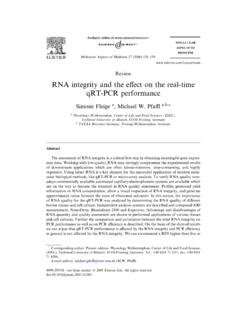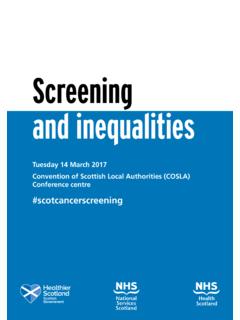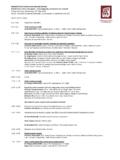Transcription of Statistical practice in high-throughput screening …
1 NATURE BIOTECHNOLOGY VOLUME 24 NUMBER 2 FEBRUARY 2006 167 Statistical practice in high - throughput screening data analysisNathalie Malo1,2, James A Hanley2, Sonia Cerquozzi1, Jerry Pelletier3 & Robert Nadon1,4 high - throughput screening is an early critical step in drug discovery. Its aim is to screen a large number of diverse chemical compounds to identify candidate hits rapidly and accurately. Few Statistical tools are currently available, however, to detect quality hits with a high degree of confidence. We examine Statistical aspects of data preprocessing and hit identification for primary screens. We focus on concerns related to positional effects of wells within plates, choice of hit threshold and the importance of minimizing false-positive and false-negative rates.
2 We argue that replicate measurements are needed to verify assumptions of current methods and to suggest data analysis strategies when assumptions are not met. The integration of replicates with robust Statistical methods in primary screens will facilitate the discovery of reliable hits, ultimately improving the sensitivity and specificity of the screening screening (HTS) is the backbone of drug discov-ery within the pharmaceutical industry. Over the past decade it has also made its way into academic settings. The combination of robotic methods, parallel processing and miniaturization of biological assays has dramatically increased throughput . The potential to increase the hit discovery rate has been offset, however, by increased research costs.
3 Despite the current popularity of HTS and major improvements inprocessing, the new drug approval rate has declined are attempting to counter this inefficiency by various means, including developing biotech-pharmaceutical alliances and changing their internal organizational structures by merging multiple disciplines associated with lead generation and validation2. Likewise, HTS programs are being integrated within academic settings where alternative targets and diseases of lesser commercial value can be explored3. At the root, the challenge is to find the next marketable drug while simultaneously maximizing the number of screened targets and compounds, minimizing costs per well and optimizing the lead genera-tion and validation kinds of inference or decision error can occur at the primary screen step: false positives and false negatives it is unclear if cur-rent inefficiencies are due mostly to the generation of too many false positives, too many false negatives or both.
4 We advance the view that improving hit specificity and sensitivity cannot be met by technological and organizational improvements alone and that improvements in data analysis methods are needed to fulfill the promise of is a large-scale process (Fig. 1) that screens many thousands of chemical compounds in order to identify potential lead candidates rapidly and accurately. Whereas the plating format and number of compounds per plate can vary, typically just a single measurement of each compound s activity is obtained in an initial primary screen. The 1 McGill University and Genome Quebec Innovation Centre, 740 avenue du Docteur Penfield, Montreal, Quebec, Canada, H3A 1A4.
5 2 McGill University Department of Epidemiology, Biostatistics, and Occupational Health, 1020 Pine Avenue West, Montreal, Quebec, Canada, H3A 1A4. 3 McGill University Department of Biochemistry, 3655 Promenade Sir William Osler, Montreal, Quebec, Canada, H3A 1A4. 4 McGill University Department of Human Genetics, 1205 avenue du Docteur Penfield N5/13, Montreal, Quebec, Canada, H3A 1B1. Correspondence should be addressed to online 7 February 2006; screen Secondary screen& counter screen Structure-activity relationship (SAR)& medicinal chemistry A biological assay(specific target& reagents) Clinical trials(phase 1, 2, 3) Leads Confirmed hits Hits Drug A largelibrary ofchemical compounds Figure 1 From HTS process to eventual drug 2006 Nature Publishing Group VOLUME 24 NUMBER 2 FEBRUARY 2006 NATURE BIOTECHNOLOGY automated process allows the testing of several hundred plates over a period of weeks.
6 Compounds identified for follow-up (labeled hits ) are evaluated for biological relevance by a counter screen and confirmed as bona fide hits by a secondary screens test many fewer compounds ( , the 1% most active compounds from the primary screen4) and typically use at least duplicate measurements. Paradoxically, compounds with the highest mea-sured activity levels on a primary screen will on average be less extreme on a secondary screen because of a Statistical artifact known as regression toward the mean 5,6. Accordingly, marginal hits on the first run may fail to validate on the second run merely because of random measurement error, although the size of the Statistical artifact can be minimized by improv-ing measurement precision ( , by obtaining replicate measurements).
7 Confirmed hits with an established biological activity according to a struc-ture-activity relationship (SAR) series and medicinal chemistry are termed leads that can develop into drug candidates for clinical Rows 1 2 3 4 5 6 7 8 9 10 11 12 ABCDEFGHE mpty wells NegativecontrolsCompound 80 Compound 1 Compound 2 Negativecontrols 1 2 3 4 5 6 7 8 9 10 11 12 ABCDEFGHC ompound 80 Compound 1 Compound 2 8 Rows Positive controlsPositive controls12 Columns12 ColumnsabFigure 2 Typical location of controls on a 96-well plate. In a primary screen, the designed biological assay is performed by using a robot to add the target of interest and specific reagents to each well, which already contain a different compound or control.
8 After incubation or other required manipulations, an activity measurement is obtained for every well by automated plate reading. These raw data represent the activity measurement of each compound or control against a specified target. The measurement units and the scales depend on the design of the biological assay, the target of interest and the specific reader or imager that is used. (a) Generally, in a compound library, 80 different compounds (gray circles) are stored in the middle of a 96-well plate and wells onthe first and last columns are left empty. Often in a high - throughput screen, eight positive controls (red circles) are placed in column 1 and four negative controls (blue circles) are placed in column 12.
9 The other four wells (white circles) in column 12 remain empty and are not used. (b) Ideally, controls should be located randomly among the 96 wells of each plate. Only the first and the last columns are typically available for controls, since compounds (gray circles) are stored in the 80 middle wells. Despite this limitation, edge-related bias can be minimized by alternating the eight positive controls (red circles) and the eight negative controls (blue circles) in the available wells, such that they appear equally on each of the eight rows and each of the two available of control. A qualitative measure of test compound activity defined aswhere xi is the raw measurement on the ith compound and c is the mean of the measurements on the positive controls in an antagonist assay.
10 Normalized percent inhibition. Another normalization method using controls:where xi is the raw measurement on the ith compound, c + and c are the means of the measurements on the positive and negative controls, respectively, in an antagonist score. A simple and widely known normalizing method calculated aswhere xi is the raw measurement on the ith compound, x and sx are the mean and the standard deviation, respectively, of all measurements within the score9. The residual (rijp) of the measurement for row i and column j on the pth plate is obtained by fitting a two-way median polish and is defined below asThe residual is defined as the difference between the observed result (yijp) and the fitted value (y ijp , defined as the estimated average of the plate ( p) + estimated systematic measurement offset for row i on plate p (R ip) + estimated systematic measurement column offset for column j on plate p (C jp)).








